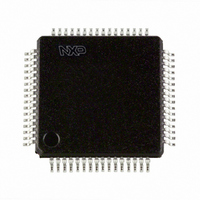SC16C750BIB64,157 NXP Semiconductors, SC16C750BIB64,157 Datasheet - Page 16

SC16C750BIB64,157
Manufacturer Part Number
SC16C750BIB64,157
Description
IC UART 64BYTE 64LQFP
Manufacturer
NXP Semiconductors
Datasheet
1.SC16C750BIA44518.pdf
(44 pages)
Specifications of SC16C750BIB64,157
Number Of Channels
1, UART
Package / Case
64-LQFP
Fifo's
64 Byte
Voltage - Supply
2.5V, 3.3V, 5V
With Auto Flow Control
Yes
With False Start Bit Detection
Yes
With Modem Control
Yes
With Cmos
Yes
Mounting Type
Surface Mount
Data Rate
3 Mbps
Supply Voltage (max)
5.5 V
Supply Voltage (min)
2.25 V
Supply Current
4.5 mA
Maximum Operating Temperature
+ 85 C
Minimum Operating Temperature
- 40 C
Mounting Style
SMD/SMT
Operating Supply Voltage
2.5 V or 3.3 V or 5 V
Lead Free Status / RoHS Status
Lead free / RoHS Compliant
Lead Free Status / RoHS Status
Lead free / RoHS Compliant, Lead free / RoHS Compliant
Other names
935274403157
SC16C750BIB64
SC16C750BIB64
SC16C750BIB64
SC16C750BIB64
Available stocks
Company
Part Number
Manufacturer
Quantity
Price
Company:
Part Number:
SC16C750BIB64,157
Manufacturer:
NXP Semiconductors
Quantity:
10 000
NXP Semiconductors
SC16C750B_5
Product data sheet
7.1 Transmit Holding Register (THR) and Receive Holding Register (RHR)
7.2 Interrupt Enable Register (IER)
The serial transmitter section consists of an 8-bit Transmit Hold Register (THR) and
Transmit Shift Register (TSR). The status of the THR is provided in the Line Status
Register (LSR). Writing to the THR transfers the contents of the data bus (D7 to D0) to the
THR, providing that the THR or TSR is empty. The THR empty flag in the LSR register will
be set to a logic 1 when the transmitter is empty or when data is transferred to the TSR.
Note that a write operation can be performed when the THR empty flag is set
(logic 0 = FIFO full; logic 1 = at least one FIFO location available).
The serial receive section also contains an 8-bit Receive Holding Register (RHR).
Receive data is removed from the SC16C750B and receive FIFO by reading the RHR
register. The receive section provides a mechanism to prevent false starts. On the falling
edge of a start or false start bit, an internal receiver counter starts counting clocks at the
16 clock rate. After 7
start bit. At this time the start bit is sampled, and if it is still a logic 0 it is validated.
Evaluating the start bit in this manner prevents the receiver from assembling a false
character. Receiver status codes will be posted in the LSR.
The Interrupt Enable Register (IER) masks the interrupts from receiver ready, transmitter
empty, line status and modem status registers. These interrupts would normally be seen
on the INT output pin.
Table 9.
Bit
7:6
5
4
3
2
Symbol
IER[7:6]
IER[5]
IER[4]
IER[3]
IER[2]
Interrupt Enable Register bits description
Description
Not used.
Low power mode.
Sleep mode.
Modem Status Interrupt.
Receive Line Status interrupt. This interrupt will be issued whenever a fully
assembled receive character is transferred from RSR to the RHR/FIFO, i.e.,
data ready, LSR[0].
logic 0 = disable Low power mode (normal default condition)
logic 1 = enable Low power mode
logic 0 = disable Sleep mode (normal default condition)
logic 1 = enable Sleep mode. See
logic 0 = disable the modem status register interrupt (normal default
condition)
logic 1 = enable the modem status register interrupt
logic 0 = disable the receiver line status interrupt (normal default condition)
logic 1 = enable the receiver line status interrupt
1
Rev. 05 — 17 October 2008
2
clocks, the start bit time should be shifted to the center of the
5 V, 3.3 V and 2.5 V UART with 64-byte FIFOs
Section 6.7 “Sleep mode”
SC16C750B
© NXP B.V. 2008. All rights reserved.
for details.
16 of 44
















